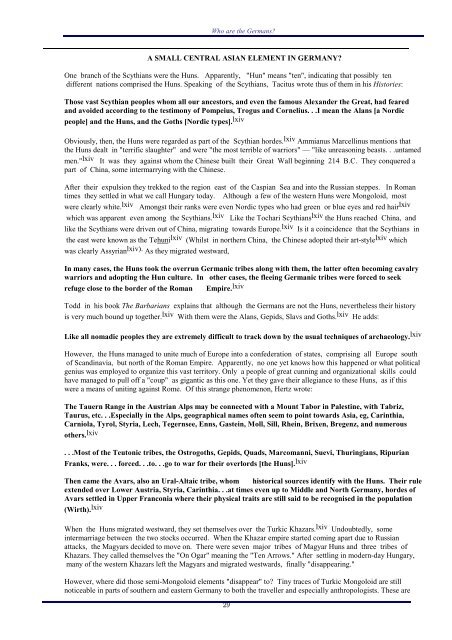WHO ARE THE GERMANS - Churches of God Cyber Auxiliary
WHO ARE THE GERMANS - Churches of God Cyber Auxiliary
WHO ARE THE GERMANS - Churches of God Cyber Auxiliary
Create successful ePaper yourself
Turn your PDF publications into a flip-book with our unique Google optimized e-Paper software.
Who are the Germans?<br />
A SMALL CENTRAL ASIAN ELEMENT IN GERMANY?<br />
One branch <strong>of</strong> the Scythians were the Huns. Apparently, "Hun" means "ten", indicating that possibly ten<br />
different nations comprised the Huns. Speaking <strong>of</strong> the Scythians, Tacitus wrote thus <strong>of</strong> them in his Histories:<br />
Those vast Scythian peoples whom all our ancestors, and even the famous Alexander the Great, had feared<br />
and avoided according to the testimony <strong>of</strong> Pompeius, Trogus and Cornelius. . .I mean the Alans [a Nordic<br />
people] and the Huns, and the Goths [Nordic types]. lxiv<br />
Obviously, then, the Huns were regarded as part <strong>of</strong> the Scythian hordes. lxiv Ammianus Marcellinus mentions that<br />
the Huns dealt in "terrific slaughter" and were "the most terrible <strong>of</strong> warriors" — "like unreasoning beasts. . .untamed<br />
men." lxiv It was they against whom the Chinese built their Great Wall beginning 214 B.C. They conquered a<br />
part <strong>of</strong> China, some intermarrying with the Chinese.<br />
After their expulsion they trekked to the region east <strong>of</strong> the Caspian Sea and into the Russian steppes. In Roman<br />
times they settled in what we call Hungary today. Although a few <strong>of</strong> the western Huns were Mongoloid, most<br />
were clearly white. lxiv Amongst their ranks were even Nordic types who had green or blue eyes and red hairlxiv which was apparent even among the Scythians. lxiv Like the Tochari Scythianslxiv the Huns reached China, and<br />
like the Scythians were driven out <strong>of</strong> China, migrating towards Europe. lxiv Is it a coincidence that the Scythians in<br />
the east were known as the Tehunilxiv (Whilst in northern China, the Chinese adopted their art-stylelxiv which<br />
was clearly Assyrianlxiv). As they migrated westward,<br />
In many cases, the Huns took the overrun Germanic tribes along with them, the latter <strong>of</strong>ten becoming cavalry<br />
warriors and adopting the Hun culture. In other cases, the fleeing Germanic tribes were forced to seek<br />
refuge close to the border <strong>of</strong> the Roman Empire. lxiv<br />
Todd in his book The Barbarians explains that although the Germans are not the Huns, nevertheless their history<br />
is very much bound up together. lxiv With them were the Alans, Gepids, Slavs and Goths. lxiv He adds:<br />
Like all nomadic peoples they are extremely difficult to track down by the usual techniques <strong>of</strong> archaeology. lxiv<br />
However, the Huns managed to unite much <strong>of</strong> Europe into a confederation <strong>of</strong> states, comprising all Europe south<br />
<strong>of</strong> Scandinavia, but north <strong>of</strong> the Roman Empire. Apparently, no one yet knows how this happened or what political<br />
genius was employed to organize this vast territory. Only a people <strong>of</strong> great cunning and organizational skills could<br />
have managed to pull <strong>of</strong>f a "coup" as gigantic as this one. Yet they gave their allegiance to these Huns, as if this<br />
were a means <strong>of</strong> uniting against Rome. Of this strange phenomenon, Hertz wrote:<br />
The Tauern Range in the Austrian Alps may be connected with a Mount Tabor in Palestine, with Tabriz,<br />
Taurus, etc. . .Especially in the Alps, geographical names <strong>of</strong>ten seem to point towards Asia, eg, Carinthia,<br />
Carniola, Tyrol, Styria, Lech, Tegernsee, Enns, Gastein, Moll, Sill, Rhein, Brixen, Bregenz, and numerous<br />
others. lxiv<br />
. . .Most <strong>of</strong> the Teutonic tribes, the Ostrogoths, Gepids, Quads, Marcomanni, Suevi, Thuringians, Ripurian<br />
Franks, were. . . forced. . .to. . .go to war for their overlords [the Huns]. lxiv<br />
Then came the Avars, also an Ural-Altaic tribe, whom historical sources identify with the Huns. Their rule<br />
extended over Lower Austria, Styria, Carinthia. . .at times even up to Middle and North Germany, hordes <strong>of</strong><br />
Avars settled in Upper Franconia where their physical traits are still said to be recognised in the population<br />
(Wirth). lxiv<br />
When the Huns migrated westward, they set themselves over the Turkic Khazars. lxiv Undoubtedly, some<br />
intermarriage between the two stocks occurred. When the Khazar empire started coming apart due to Russian<br />
attacks, the Magyars decided to move on. There were seven major tribes <strong>of</strong> Magyar Huns and three tribes <strong>of</strong><br />
Khazars. They called themselves the "On Ogar" meaning the "Ten Arrows." After settling in modern-day Hungary,<br />
many <strong>of</strong> the western Khazars left the Magyars and migrated westwards, finally "disappearing."<br />
However, where did those semi-Mongoloid elements "disappear" to? Tiny traces <strong>of</strong> Turkic Mongoloid are still<br />
noticeable in parts <strong>of</strong> southern and eastern Germany to both the traveller and especially anthropologists. These are<br />
29


